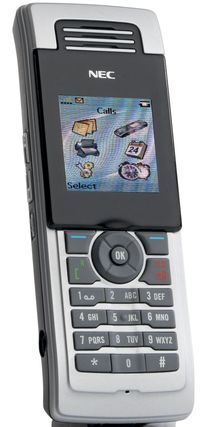NEC Unified Solutions, a division of NEC Corp. providing business telecommunications solutions, has begun integrating real-time locating system (RTLS) software from Ekahau to provide NEC’s IP Digital Enhanced Cordless Telecommunications (DECT) mobile phones with location-tracking capabilities. With the new technology, if an individual carrying a DECT handset has an emergency, or if management needs to locate a worker who has such a device, Ekahau software can pinpoint its location. The system (which will be sold by NEC) includes a DECT handset and DECT wireless access points to receive telephony signals, as well as Ekahau’s software that identifies a handset’s location based on the strength of its signal as received by the access points. The system is commercially available now in European markets, says Robert van Amerongen, NEC Unified Solutions’ manager of marketing communications.
DECT is a telecommunications standard commonly used in Europe, as well as in parts of Asia, Australia and South America. The standard enables communication between a portable unit, such as a cordless phone, and fixed receivers, using a segment of the 1880 MHz to 1930 MHz frequency band, depending on the region of the world in which the system is used. Businesses, universities and hospitals often utilize the standard to provide a voice communication network with mobile phones among their staff, similarly to how North American companies often use Wi-Fi for voice over IP (VoIP).
NEC saw a need for location technology among its users, and began working last year with Ekahau, which offers RTLS solutions for devices that communicate over a Wi-Fi network. Without the RTLS technology, users of the NEC phone have little idea as to the handset’s location, either when a call is being placed or when it is idle. There are a variety of reasons, however, why companies might want to track a handset’s location—the primary being safety: If a security guard or other employee uses an RTLS-enabled DECT handset to place an emergency call, the company would not have to rely on that worker describing where he or she is located. There are other uses as well, including tracking an employee’s general location within a large facility, such as at an industrial complex, a university campus or an event center (a football stadium, for instance), or locating a misplaced phone.
NEC’s RTLS-enabled DECT system comes with Ekahau software built into the handset, NEC’s IP DECT version 5.0 software, and NEC AP200 or AP300 Series access points to capture voice calls from the handsets. A server hosted by Ekahau receives data from the handset, and the Ekahau Positioning Engine V 4.6 software, running on that server, determines its location and issues related alerts to the users.
Ekahau is providing only software to the existing NEC IP DECT solution, using the existing DECT transmission between the handset and the access points to calculate location. In this way, says Tuomo Rutanen, Ekahau’s VP of business development, there is no need to embed Ekahau Wi-Fi-based RTLS tags in the phones.
When an individual moves around an area in the NEC coverage zone, the handset transmits that information to the nearest access points, whether the phone is in use or idle. The handset transmits its unique identifier at regular intervals to any access points in the vicinity. Ekahau’s positioning engine software receives that identifier, as well as the signal strength, from each access point receiving the transmission. It then calculates the handset’s location and sends out alerts, if appropriate, to interested parties, such as campus security, company management or facilities managers.
In addition, if a technology user wishes to locate a specific handset in real time, he or she can log onto the Ekahau server and input that device’s ID number, in order to view its location status within several meters.
The technology is currently being piloted at a location in Switzerland, as well as in the United Kingdom, though NEC and Ekahau both decline to name the end users involved.
According to Rutanen, Ekahau’s solution works as well with DECT signals as it does with Wi-Fi. “While our business is built around Wi-Fi, there are other radio technologies out there that can take advantage of the same solution,” he states.
“The RTLS functionality adds the elements of additional security to NEC customers in case of emergencies,” van Amerongen says, but it can also be applied for customer service in hospitality environments, as well as to improve staff efficiency.



